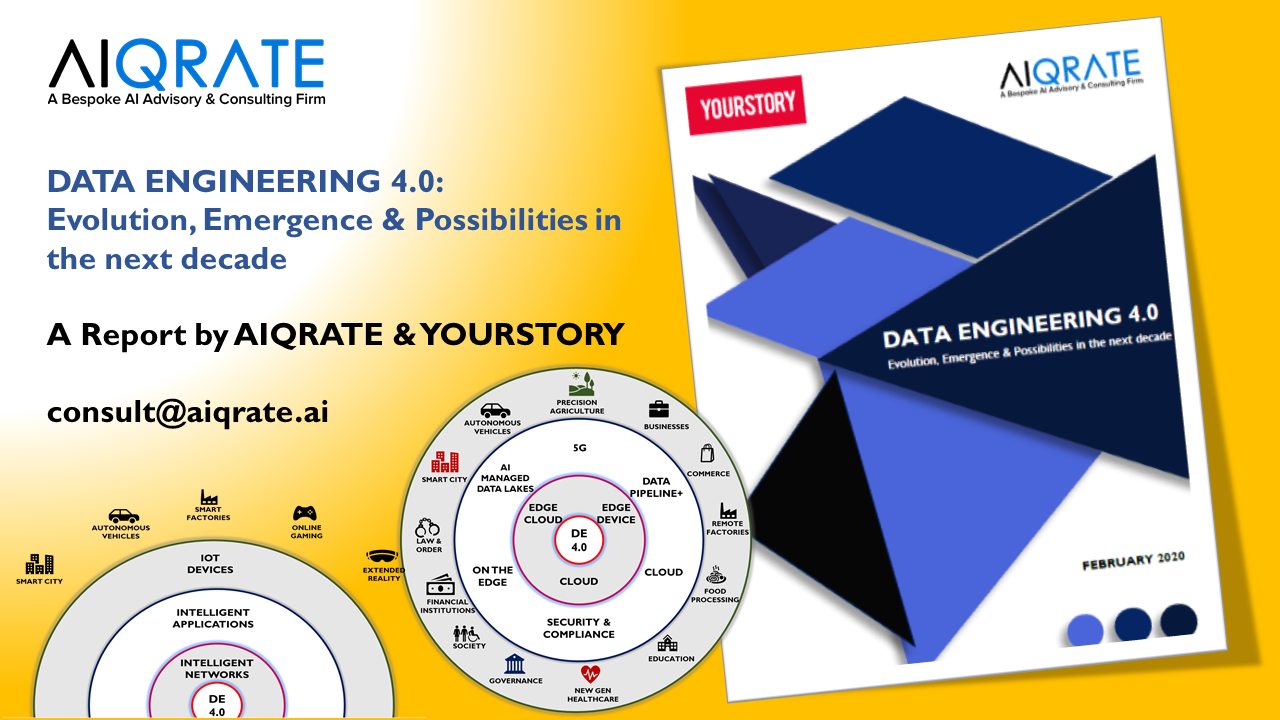
REPORT: Data Engineering 4.0: Evolution, Emergence and Possibilities in the next decade
Add Your Heading Text Here

Today, most technology aficionados think of data engineering as the capabilities associated with traditional data preparation and data integration including data cleansing, data normalization and standardization, data quality, data enrichment, metadata management and data governance. But that definition of data engineering is insufficient to derive and drive new sources of society, business and operational value. The Field of Data Engineering brings together data management (data cleansing, quality, integration, enrichment, governance) and data science (machine learning, deep learning, data lakes, cloud) functions and includes standards, systems design and architectures.
There are two critical economic-based principles that will underpin the field of Data Engineering:
Principle #1: Curated data never depletes, never wears out and can be used an unlimited number of use cases at a near zero marginal cost.
Principle #2: Data assets appreciate, not depreciate, in value the more that they are used; that is, the more these data assets are used, the more accurate, more reliable, more efficient and safer they become.
There have been significant exponential technology advancements in the past few years ; data engineering is the most topical of them. Burgeoning data velocity , data trajectory , data insertion , data mediation & wrangling , data lakes & cloud security & infrastructure have revolutionized the data engineering stream. Data engineering has reinvented itself from being passive data aggregation tools from BI/DW arena to critical to business function. As unprecedented advancements are slated to occur in the next few years, there is a need for additional focus on data engineering. The foundations of AI acceleration is underpinned by robust data engineering capabilities.
YourStory & AIQRATE curated and unveiled a seminal report on “Data Engineering 4.0: Evolution , Emergence & Possibilities in the next decade.” A first in the area , the report covers a broad spectrum on key drivers of growth for Data Engineering 4.0 and highlights the incremental impact of data engineering in the time to come due to emergence of 5G , Quantum Computing & Cloud Infrastructure. The report also covers a comprehensive section on applications across industry segments of smart cities , autonomous vehicles , smart factories and the ensuing adoption of data engineering capabilities in these segments. Further , it dwells on the significance of incubating data engineering capabilities for deep tech startups for gaining competitive edge and enumerates salient examples of data driven companies in India that are leveraging data engineering prowess . The report also touches upon the data legislation and privacy aspects by proposing certain regulations and suggesting revised ones to ensure end to end protection of individual rights , security & safety of the ecosystem. Data Engineering 4.0 will be an overall trojan horse in the exponential technology landscape and much of the adoption acceleration that AI needs to drive ; will be dependent on the advancements in data engineering area.
Please fill in the below details to download the complete report.
Related Posts
AIQRATIONS

The Power of AI can radically improve the Engineering & Construction industry
Add Your Heading Text Here

Why AI in construction?
Of all the game-changing innovations driven by technology and artificial intelligence in the world today, the potential of one key sector remains untapped – the construction industry.
According to McKinsey, the engineering and construction sector globally is valued to be worth $10 tn per year. While that is a respectable size, the construction industry overall has largely been slow in the uptake of inventions in the technology arena. In fact, several construction business houses in India tend to be family-owned and extremely traditionally-run, and have tremendous inertia in embracing new age technologies.
However, the past few years is seeing a change in the way construction firms operate. With well-funded global start-ups such as WeWork entering the fray with an AI and analytics forward approach to real estate development; industry incumbents need to up their game in order to stay relevant. While McKinsey expects the permeation of AI in the construction industry to be modest right now, it does represent an opportunity for early adopters to catch the bull by the horns and build a sizeable competitive advantage. Those from this industry that have a ponderous and slow uptake of new technology will surely be eaten up by their competitors. Through this article, we explore some artificial intelligence interventions that can be transformative for the construction and real estate industry at large.
Image recognition for managing risk, safety and quality
The construction industry would do well to adopt these techniques and apply them to manage risk and worker safety. Working conditions in the construction industry for labourers tend to be managed mediocrely at present. We hear of numerous cases of mortality and severe injuries where workers do not follow established safety procedures. Other cases also include unsafe working environments where certain infrastructure in overall construction projects are unsafe for human work.
Construction companies could employ drones to capture images and videos of their construction sites on a continuous basis. By applying deep learning and other AI techniques, firms would be able to identify unsafe workplace behaviour as well as unsafe working environments and run training interventions to improve the safety quotient of their workplaces.
Continuous design optimisation
Construction activity has largely been seen as a waterfall-like process where all the designs, construction materials and their feasibility are evaluated at the start of the project. While this is undoubtedly a watertight approach to construction, it does cause delays in planning, leading to lost revenue opportunity in the near term.
Today, with data readily available for analysis, AI can help continuously optimise the design of each project. A recommender system-like approach would help contractors and engineers identify the right design as well as the materials required to execute it. Additionally, AI-powered technology could also help recommend architectural finishes based on the proposed design – thus enabling construction firms to finalise the design and material requirements early in the schedule, and finish construction faster.
Increasing talent retention and development
The construction sector is remarkably disorganised and heavily relies on contract labour for executing a project. While minor, the cost and time involved in fulfilling positions left by ex-labourers and training new entrants really adds up and reduces the overall efficiency in project management. In India, contract labour can often also be seasonal, with numerous workers migrating to their hometowns in droves leading to longer gestation periods for projects.
AI has been applied to talent retention and talent development use cases in multiple industries, and the same can be applied to the construction industry with relative ease. With unsupervised machine learning algorithms, contractors and their parent companies will be able to forecast talent shortage accurately, and plan to backfill labour resources efficiently. AI can also enable improved labour retention strategies by recommending best options for ensuring improved talent retention and availability.
Project schedule optimisation
Construction projects are typically long drawn with a sizeable period elapsing between envisioning the project to having it commercially ready. In this period, we often see many niggles with respect to the project schedule. Overuse of materials, time-consuming nature of restocking, people availability issues – all these can throw the overall project plan into disarray.
Preventive maintenance through AI
Maintenance in the construction industry happens largely at two levels. Firstly, it is the maintenance of a partially and incrementally developing property. The second is when the builder organisation is responsible for the continuing maintenance after it has been leased out to tenants. At both levels, maintenance can be a hugely cumbersome and time-consuming activity, albeit critical, that the construction company must perform in order for operations to move smoothly.
We live in a world of sufficiently advanced technology and AI can complement human effort in the process of preventive maintenance. By using sensors and cameras as the data capture layer, and applying machine learning algorithms over the data, facility managers can monitor their property with greater ease and identify guided interventions on where maintenance activity is required. Using this data can be doubly productive as it will provide the system inputs on when routine maintenance activity for all the working components of a modern property are required, and schedule accordingly.
A technology-driven paradigm shift is fast coming for the construction industry. As things stand right now, the industry employs close to 7 percent of the global labour workforce. The strong uptake of infrastructure projects notwithstanding, the sector has grown only 1 percent per year for the past decades – with a flatlining per worker productivity, incumbents would do well to embrace the wave of Artificial Intelligence to power their next phase of growth. Using AI techniques, engineering and construction industry giants would be able to accelerate productivity, increase business efficiency and bring a much-needed technology facelift to the industry.

